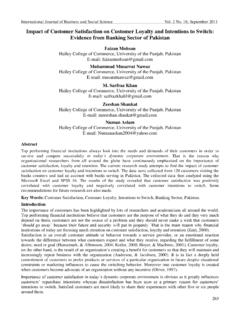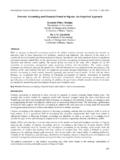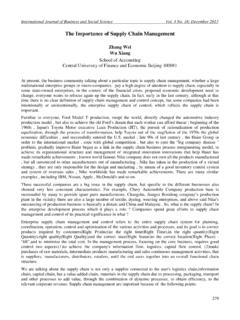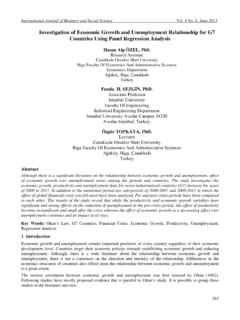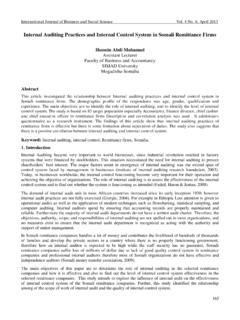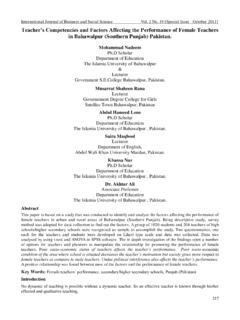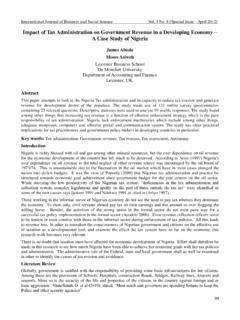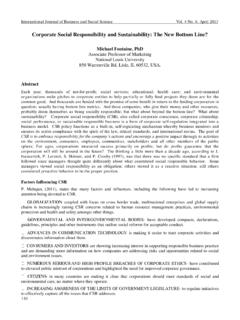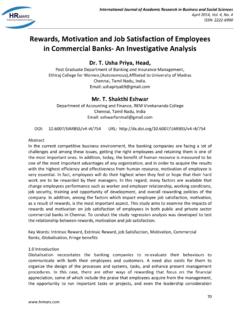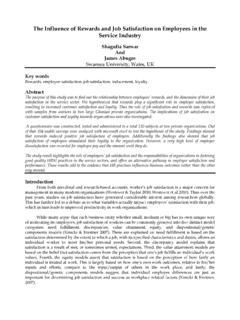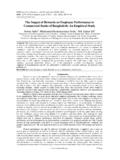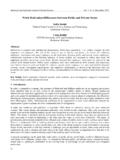Transcription of Effects of Motivation and Job satisfaction on Employees ...
1 International Journal of Business and Social Science Vol. 4 No. 6; June 2013 212 Effects of Motivation and Job satisfaction on Employees Performance at Petrovietnam Nghe an Construction Joints Stock Corporation (PVNC) PhD. Nhat Nguyen Cong Vinh University Vietnam. PhD. Dung Nguyen Van Nghe An College Vietnam. Abstract Employers are faced with the task of motivating Employees and creating high job satisfaction among their staff. Creating programs and policies that develop job satisfaction and serve to motivate Employees takes time and money to create. When the employer understands the benefits of job satisfaction and Motivation in the workplace, though, the investment in employee-related policies can be justified.
2 The purpose of any Motivation programme is to motivate the organization s Employees to enable them work effectively. However, motivating Employees is not an easy thing as what motivates Employees differs among people. This paper intended to establish a set of factors that can motivate Employees of PVNC and to establish the policy implications of these factors for managing staff of the PVNC. It was found that Pay and Promotion is the most important motivational factor followed by Good working conditions. The paper revealed that these two factors are not the only factors that are needed to motivate Employees of the PVNC. Other factors, including Interesting works and Promotion and growth in the organization, are equally important depending on the type of motivational theory that is adopted.
3 The study finally stresses the avoidance of disparities in pay/reward among staff of the same rank as a strategy to motivate and retain high quality staff in the PVNC. The study thus raises red flags that warn the management to be extra careful in their attempt to motivate staff of PVNC for effective. Keywords: Employee Motivation , employee performance 1. Introduction Effort towards developing a motivated workforce for the purpose of improving productivity remains the single most crucial function of heads of institutions in recent times. Why? The reason is provided by Kreisman (2002) who argues that the most valuable and volatile asset of any institution is a well-motivated and stable workforce which is competent, dedicated and productive.
4 Interestingly, what motivates Employees changes constantly? Explaining the dynamic nature of Motivation , Kovach (1987) cites the example that as Employees income changes, money ceases to be a motivational factor; and as Employees grow older, interesting work becomes a motivational factor by Homans (1950). Hence, the declaration by Lindner (2004) is justified to write that of all the functions a manager performs, motivating Employees is the most complex, as employee Motivation is a never ending challenge. Heads of institutions thus face difficult challenge of motivating and retaining Employees especially in an environment of increased uncertainties such as PVNC where groups of workers usually deliberately stop working because of disagreement about pay and conditions of service and transferred to the private companies, corporations increasingly by better treatment policy.
5 It would however look absurd for the university authorities to attempt to motivate the Employees when the authorities do not know what motivate these. Objectives of the study The key to motivating Employees is to know what motivate them and design a motivational programme based on those needs. Therefore the objective of this paper is to describe the importance of certain factors which motivate Employees of the PVNC. Specifically, the paper seeks to describe the rank importance of some selected motivational factors, taking into consideration some theories of selected factors (indicators) are: career development opportunities; job security; Pay and Promotion; Good working conditions; Feelings of being in on things with personal problems; Feelings of being in on things with personal problems; Interesting works; Personal or company loyalty to Employees ; Tactful discipline; and Reputation of Institution.
6 Center for Promoting Ideas, USA 213 What is Motivation and Job satisfaction ? The term Motivation has been defined variously by different authorities in the study of Psychology, Management and allied disciplines. According to Cole (2009), Motivation is essentially about what drives a person to work in a particular way and with a given amount of effort. To Buford et al (1995), Motivation is a pre-disposition to behave in a purposive manner to achieve specific needs. Obviously, there are divergences in these definitions, though some common threads seem to exist.
7 What is common to the foregoing definitions, among others, is that something has to trigger an employee to perform in an exceptional way. For purpose of this paper, Motivation is operationally defined as a set of indefinite factors that cause a person (an employee) to perform his or her duties in a special way. The factors are described as indefinite because they constantly change with time, as pointed out by Kovach (1987). What is implicit in this definition is that an employee will not work in that special way if he or she is not encouraged (motivated) to do so. An understanding of this definition depends on the appreciation of some existing theories of Motivation .
8 Job satisfaction is a general attitude towards one s job (Schermerhorn, Hunt & Osborn 1997; Robbins, 2001). Motivation is a process of satisfying Employees different needs and expectations; therefore, administrators have to be aware of and analyze those unique, individual needs. Administrators have the difficult task of actualizing performance above the current level of Employees and colleagues performance. They have to increase Employees attention towards organizational targets and direct their behavior towards the achievement of corporate targets. Theories of Motivation Among the earliest and well-known researchers in the Motivation domain were Homans (1950) and Maslow (1954).
9 The former identified three key elements (activities, interactions and sentiments) as the controlling factors of members in an informal group. Homans (1950) defines activities as the task performed by the members of an informal group. He refers to interactions as the relationship among the members; and explains sentiments as the individual and collective attitudes of these members. Homans regards these three elements as independent because, according to him, a change in any one of them affects the other two elements. Maslow (1954) on the other hand developed the need-hierarchy theory. In his theory, Maslow postulated that people s ( Employees ) needs are arranged in a hierarchy in which basic needs generally have to be satisfied before higher needs come to play.
10 Maslow s idea did not escape criticisms and has hence been modified by other theorists notably Alderfer (1969) who introduced the idea of need along a continuum rather than in a hierarchy. Herzberg et al (1987) view Motivation with different lenses. Their idea is today known as the Herzberg two-factor theory as it reduces the factors of Motivation to two namely intrinsic and extrinsic factors. The former, which includes achievements and recognition, produces job satisfaction , whilst the latter comprising Pay and Promotion and job security is often a source of lack of Motivation on the part of Employees . There is also the McClelland Achievement Theory which is based on the idea that the single most important motive is the need for achievement.
